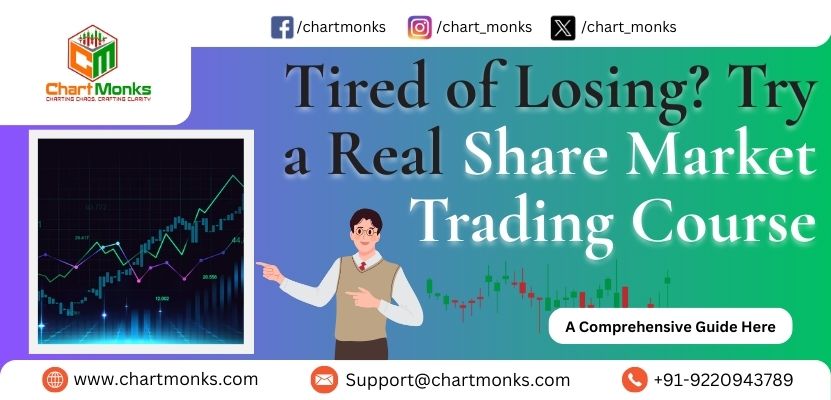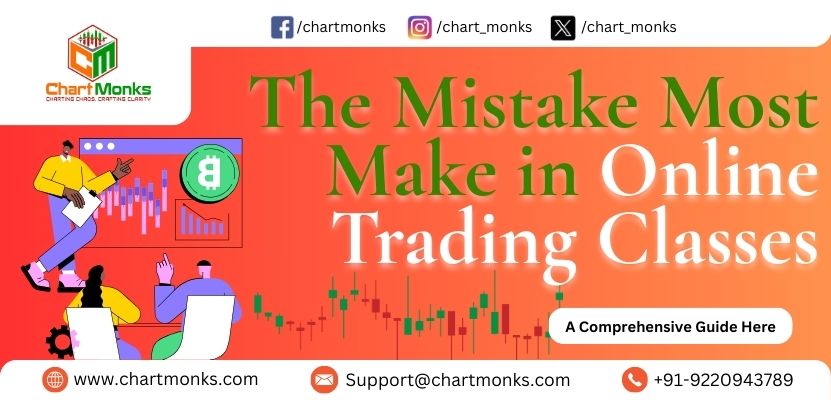Let’s be brutally honest.
Most retail traders aren’t trading the market — they’re trading opinions, signals, and noise.
You check Instagram. Someone’s calling a breakout.
You open YouTube. Another guy’s drawing 6 trend lines and shouting “BUY NOW!”
Your indicator flashes green. You enter. You lose. You repeat.
And somehow, you blame yourself.
At Chart Monks, we’re not here to hype you up with fancy patterns and false hope.
We’re here to show you what the market actually listens to: Price. Raw price. Driven by demand and supply.
No indicators. No guesswork. No fluff.
That’s the foundation of our technical analysis stock market course — and it’s the one thing most people skip.
Why Most Traders Stay Stuck at Level 1
You want the truth?
Most traders never move past the surface. They spend months (or years) learning tools that do nothing except make charts more complicated:
- Indicators on top of indicators
- Five versions of support and resistance
- Trend lines drawn from every swing point
- Candlestick patterns named after animals and weapons
It looks smart. But it’s just decoration. None of it shows why price moves.
And if you don’t understand why, you’ll always be late, lost, and reacting.
That’s why our stock market technical analysis course throws all of that out the window.
We don’t teach you how to predict the market.
We teach you how to read it.
The Market Moves for One Reason Only
Not trendlines.
Not MACD crossovers.
Not chart patterns.
Orders.
Every move you see — up or down — is a result of big players placing buy and sell orders.
That’s what creates imbalances. That’s what creates movement.
And that’s exactly what demand and supply zones reveal.
They show you:
- Where large buy orders (demand) are sitting
- Where heavy selling pressure (supply) exists
- Where price is likely to reverse or explode — not because of magic, but because of logic
This is the core of real price action. And it’s the core of what we teach at Chart Monks.
Pure Price Action Doesn’t Need a Crutch
Ever notice how the more indicators you add, the more confused you get?
That’s because they don’t remove uncertainty — they multiply it.
You end up:
- Waiting for confirmation from 3 different tools
- Seeing mixed signals at every level
- Hesitating because nothing “aligns perfectly”
We don’t do that.
Our strategy is brutally simple:
Mark your zones. Wait for the price to come to you. React based on what price shows you.
It’s not emotional. It’s not dependent on anyone.
And once you master it, you’ll never want to go back to the noisy way of trading.
Why 95% of Traders Fail (And How the Other 5% Think)
Losers chase.
Winners wait.
It sounds cliché, but it’s the raw truth.
Most traders:
- Chase breakouts
- Enter after price has already moved
- React emotionally
- Trade all day
- Lose often, win small
But the 5% who actually make money?
They’re selective. Surgical. Silent.
They mark clean demand and supply zones.
They wait.
And when price taps those zones, they’re ready — like snipers, not machine gunners.
This mindset doesn’t come from motivation.
It comes from clarity — and that clarity only comes when you stop relying on junk and start reading prices.
That’s exactly what our technical analysis stock market course is designed to build in you.
What You’ll Learn at Chart Monks (That Most Courses Ignore)
We’ve seen what other so-called “technical analysis” courses teach.
We’ve seen the clutter, the copy-paste theories, the recycled strategies from free videos.
You won’t find that here.
Our stock market technical analysis course teaches you:
- The psychology behind price movement — how demand and supply actually function in the real world
- How to identify untouched institutional zones where price is likely to reverse
- How to time entries inside those zones using raw price structure — no patterns, no gimmicks
- How to filter out low-quality zones so you’re not trading just because you’re bored
- How to think like a professional trader, not an overtrading gambler
This isn’t a strategy. It’s a skill.
And it stays with you for life.
A New Way to Look at Charts
Once you understand price through the lens of demand and supply, charts stop looking like chaos.
You no longer feel the urge to “do something” every five minutes.
You’re no longer at the mercy of tips, tweets, or trend lines.
You become calm.
Because you’ve finally seen what’s underneath all the noise.
And once you see it, you can’t unsee it.
You Don’t Need 20 Trades a Week. You Need 2 Good Ones
Most traders are addicted to activity.
They think trading more equals making more.
Wrong.
Real traders trade less. But they hit hard when they do.
At Chart Monks we teach you how to be patient, focused, and sharp.
You don’t need to be in every trade — you just need to be in the right ones.
That shift alone will:
- Save your capital
- Reduce emotional decisions
- Increase your edge
- And give you actual confidence — not fake confidence built on lucky wins
Don’t Wait Until You Burn Out
Almost every serious trader eventually finds their way to demand and supply.
But usually after:
- Blowing multiple accounts
- Wasting time on indicator-based strategies
- Buying courses that never actually explain why price moves
- Feeling like maybe trading “just isn’t for them”
If you’re reading this, you’ve already felt that frustration.
You can keep circling. Or you can cut straight to the part that works.
Our technical analysis stock market course isn’t a magic fix.
But it is a real path to building skill and clarity — from the ground up.
No fluff. No tricks. Just price, logic, and execution.
Final Words: You’re Either Chasing the Market, or You’re Controlling Yourself
Here’s what nobody tells you:
Trading isn’t about controlling the market.
It’s about controlling yourself long enough to read what price is actually telling you.
And the only way to do that is to remove the layers that distract you — indicators, lines, systems, noise — and come back to the basics:
Buy where there’s demand. Sell where there’s supply. Let price tell the rest.
If that’s the kind of trader you want to become,
Check out our stock market technical analysis course
Learn how to see charts differently.
Learn how to trust your zones.
Learn how to trade like a professional — not a hopeful gambler.
The market doesn’t owe you anything. But it does leave clues.
We’ll show you how to read them.




.jpg)